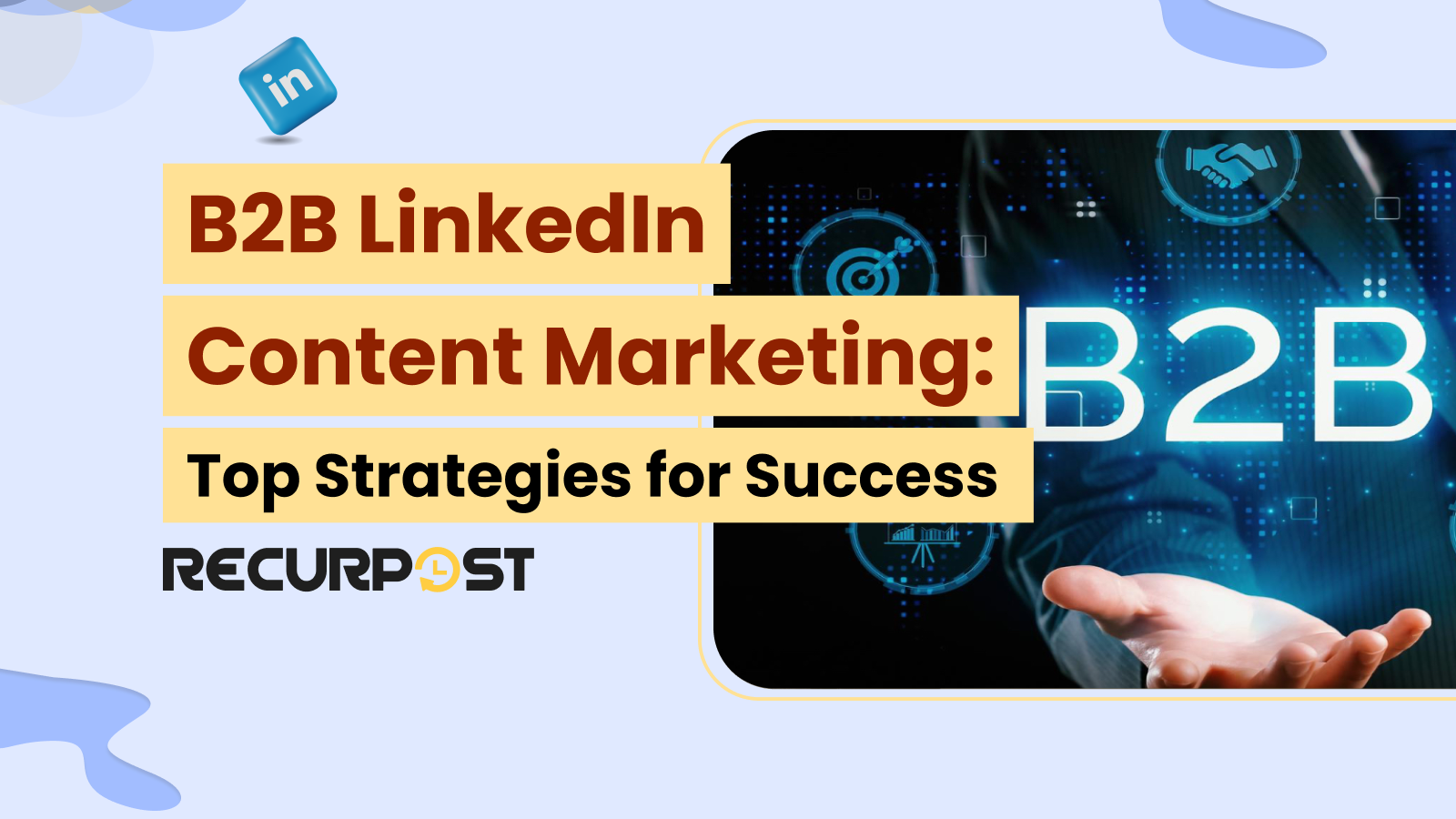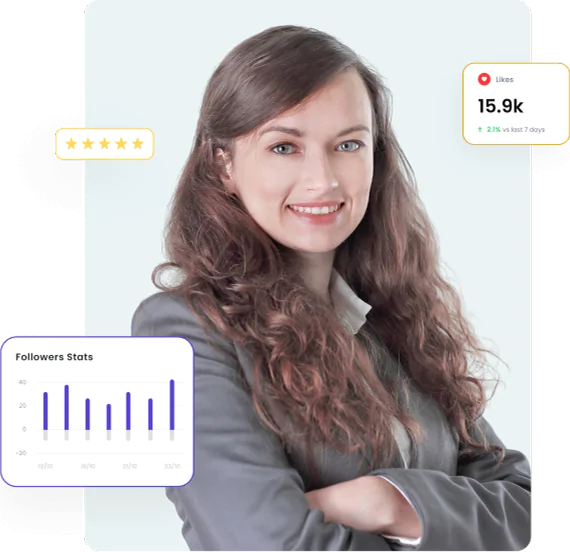B2B LinkedIn content marketing has become a great online hub, giving brands a direct line to decision-makers, stronger visibility, and qualified leads.
Today, businesses that master B2B LinkedIn content marketing consistently outperform peers on brand visibility and lead generation. With more than 900 million users, LinkedIn is the top choice for B2B marketers, offering unmatched access to professionals across every industry.
A 2024 survey found that 86% of B2B marketers use LinkedIn for their marketing, making it the leading social media channel for business engagement.
With Gen X, Millennials, and Gen Z flocking to LinkedIn to network, share ideas, and explore opportunities, businesses can reach a precise audience. Strong B2B LinkedIn content marketing ensures that content resonates across these generations and turns visibility into qualified leads. From thought leadership posts to lead generation, LinkedIn content plans help companies boost recognition, grow trust, and build lasting connections.
Mastering LinkedIn for B2B Lead Generation
Want to master LinkedIn B2B lead generation and turn the platform into your biggest lead source? Don’t miss our free guide packed with smart strategies to repurpose content, automate posts, and drive consistent, high-quality leads.
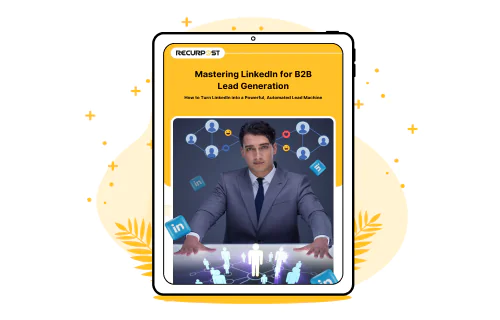
What is B2B LinkedIn Content Marketing?
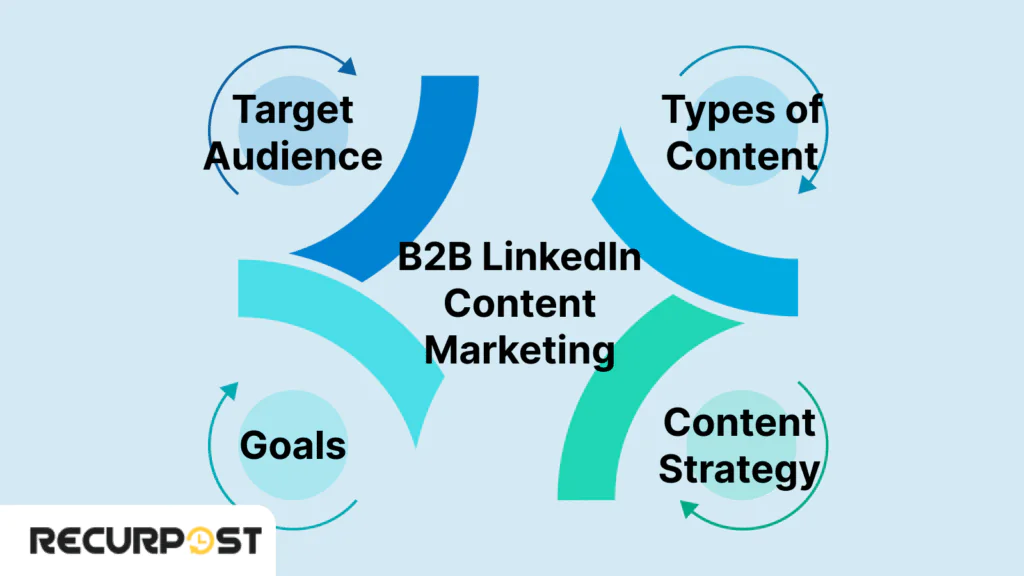
B2B LinkedIn content marketing is the practice of creating and sharing content on LinkedIn to engage a business audience. A well-planned B2B LinkedIn content marketing strategy helps companies align posts with audience needs and sustain long-term results. Here’s how it works:
1. Target Audience
- Focus: This form of LinkedIn marketing speaks directly to professionals, businesses, and decision-makers. Unlike B2C, it’s built around smaller, high-value audiences.
- Key Players: Executives, managers, and industry leaders make up the main group of readers and buyers.
2. Types of Content
- Thought leadership articles: Position your brand as a trusted voice in the industry.
- Industry insights: Share trends, data, and forecasts that matter to professionals.
- Long-form content: Extended posts and articles that dive into detailed topics.
- Case studies: Real-world examples of how businesses benefit from your services.
- Video and webinars: Visual formats that showcase expertise and offerings.
- Engaging formats: Polls, carousels, and newsletters that keep audiences active.
3. Goals of B2B LinkedIn Marketing
- Brand identity: Build recognition as a trusted name in your industry.
- Engagement: Form relationships with businesses, influencers, and prospects.
- Lead generation: Publish content that attracts qualified leads and nurtures them through the sales funnel.
4. Content Plan
- Practical guidance: Share content that addresses business challenges and shows how your services create value.
- Educational content: Post how-to guides, industry updates, and resources that inform your audience.
- Relationship building: Reply to comments, join LinkedIn groups, and share insights that spark conversations.
5. How It Differs from B2C
- B2B focus: Built to show how products or services drive growth and solve business challenges.
- Professional tone: Written to deliver value and insight instead of light entertainment.
- Decision-maker engagement: Designed to reach those who hold purchasing power in organizations.
Create LinkedIn Posts That Get Noticed
Generate professional, high-performing posts in seconds—tailored for your industry and audience.
Power Your LinkedIn Presence – Try It Free
Why LinkedIn is Ideal for B2B Marketing
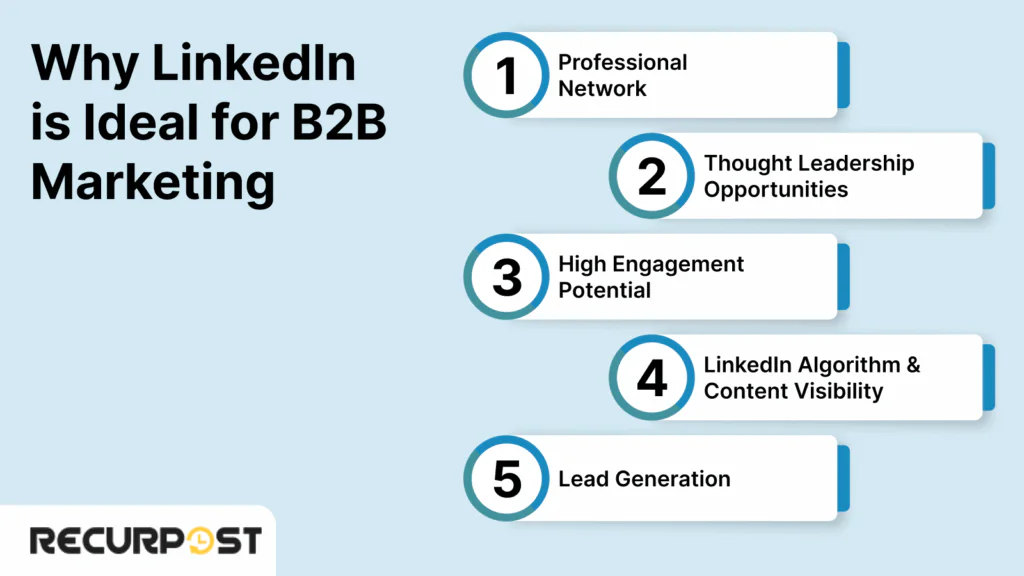
LinkedIn stands out as the most effective platform for B2B LinkedIn content marketing and overall B2B marketing, where businesses should use LinkedIn as a platform for B2B marketing by leveraging its professional network of 900 million users, positioning themselves as thought leaders through insightful content, utilizing LinkedIn’s algorithm updates that prioritize valuable business content, and employing lead generation tools like LinkedIn Ads and InMail for direct decision-maker outreach. With over 900 million professionals worldwide, it’s the hub where businesses connect with decision-makers and industry leaders. Here’s why it’s the top choice for B2B marketers:
1. Professional Network
- Targeted Audience: LinkedIn brings together professionals from various industries, allowing you to reach the right people with your content.
- Business Relationships: The platform encourages networking, making it easier to build long-lasting professional relationships with potential clients and collaborators.
- LinkedIn functions as the ideal platform for B2B LinkedIn content marketing in 2025 by connecting businesses with their target audience for lead generation and content sharing, while its professional networking focus builds relationships and fosters engagement within the B2B space.
2. Thought Leadership Opportunities
LinkedIn positions businesses as industry experts when they regularly share insightful articles, updates, and engaging posts that build credibility within their field and establish thought leadership.
3. High Engagement Potential
LinkedIn users engage more with business-relevant content, which attracts meaningful interaction and generates higher-quality leads through LinkedIn content marketing efforts. Content such as case studies, success stories, and industry insights resonates well with professionals seeking business solutions.
4. LinkedIn Algorithm and Content Visibility
LinkedIn’s 2024 algorithm update prioritizes valuable content from business pages and personal profiles, making posts more visible to target audiences and increasing engagement and lead generation opportunities. The platform’s algorithm promotes posts with high engagement rates; the more interaction your content gets, the higher its visibility.
5. Lead Generation
LinkedIn’s lead generation tools like LinkedIn Ads, InMail, and Lead Gen Forms, make it easy for businesses to collect high-quality contact information directly from interested professionals. You can also use LinkedIn Groups to target specific industries or interests and attract relevant connections.
Key Components of a Successful B2B LinkedIn Content Marketing Plan
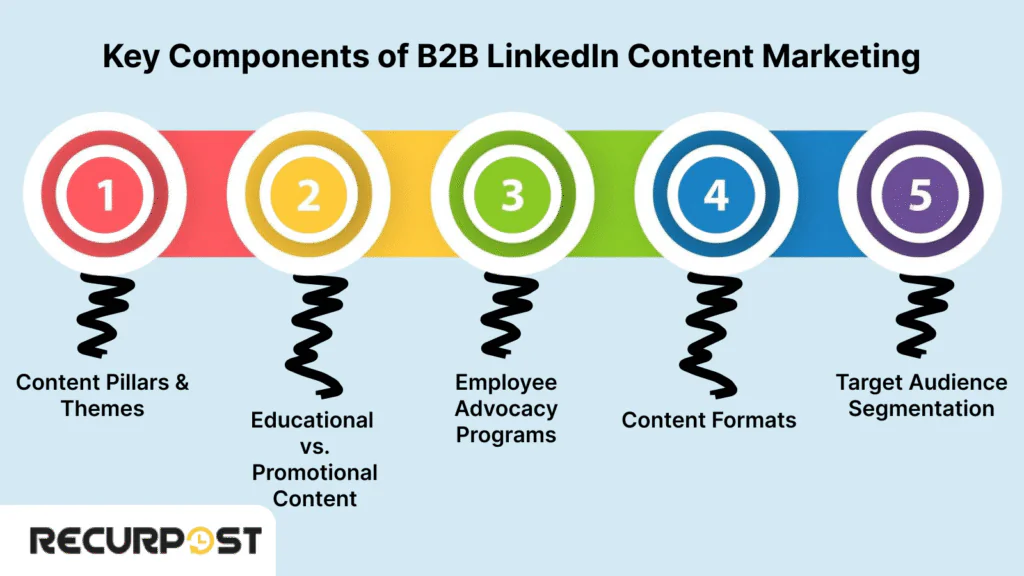
LinkedIn stands out as the strongest platform for B2B LinkedIn content marketing, where businesses use LinkedIn B2B marketing to reach a professional audience. A well-structured B2B LinkedIn content marketing plan ensures your posts align with audience expectations and drive measurable outcomes. It allows brands to position themselves as thought leaders with insightful posts, adapt to the LinkedIn algorithm updates, and run LinkedIn lead generation marketing campaigns through tools like LinkedIn Ads and InMail messaging.
1. Professional Network
- Target Audience Segmentation: LinkedIn brings together professionals across industries, making it easier to share audience-specific content that reaches the right readers.
- Business Relationships: The platform fosters relationship building, enabling companies to engage in B2B social selling on LinkedIn and establish meaningful partnerships..
In 2025, LinkedIn will function as the leading space for corporate LinkedIn marketing by connecting companies with their target audience. Through consistent posting, content repurposing, and active engagement, businesses gain higher engagement rates and strengthen long-term professional networks with the B2B LinkedIn content marketing efforts.
Best Times to Post on LinkedIn
2. Thought Leadership Opportunities
LinkedIn positions brands as experts when they share LinkedIn thought leadership articles, success stories, and LinkedIn newsletters. These formats not only boost visibility but also support employee advocacy programs by amplifying team voices. By blending educational content with promotional content, businesses grow recognition and expand their brand awareness.
Free Download Social Media Strategy Template
3. High Engagement Potential
B2B LinkedIn content marketing attracts stronger interaction than many other social media platforms, driving measurable conversion rates. Posts like LinkedIn carousel posts, LinkedIn video content, and company culture posts resonate with professionals looking for practical insights.
By mixing content pillars(such as educational vs. promotional balance) with strong call-to-action implementation, companies see growth in click-through rates and qualified leads.
4. LinkedIn Algorithm and Content Visibility
LinkedIn’s 2024 algorithm update rewards a value-driven content approach. Posts with audience interaction(such as question-based posts, comment replies, or interactive elements) gain better reach. High engagement response strategy increases visibility, helping businesses track impressions, reach, and post frequency effectiveness.
How to Write High-Impact Captions for B2B LinkedIn Content Marketing
Your caption is what makes users read, react, or scroll on. Make it count. Here’s a quick formula:
The 4-Part B2B Caption Framework:
1. Hook – A bold question or statement
“Struggling to get decision-makers to respond?”
2. Value Add – What they’ll learn or get
“Here’s the exact 3-part DM formula that gets us a 45% response rate.”
3. Visual/CTA Tie-In – What’s inside the post and what to do next
“Slide 2 has the message. Slide 5 shows real replies.”
4. Call to Comment or Share
“What’s worked for your outreach? Drop it below.”
Example Captions:
- “Stop saying ‘Let me know your thoughts.’ Say this instead—”
- “Most sales messages die in the first sentence. Here’s how to write one that gets a reply.”
- “This strategy added $100K in pipeline in 90 days. No paid ads. Just LinkedIn.”
5. Lead Generation
LinkedIn’s lead generation tactics make it simple to capture prospects. Tools like LinkedIn lead gen forms, LinkedIn events, and LinkedIn groups participation allow businesses to attract qualified leads. When paired with account-based marketing and strategic tagging, companies see measurable results in sales attribution, roi measurement, and follower growth rate.
How to Plan B2B LinkedIn Content Marketing
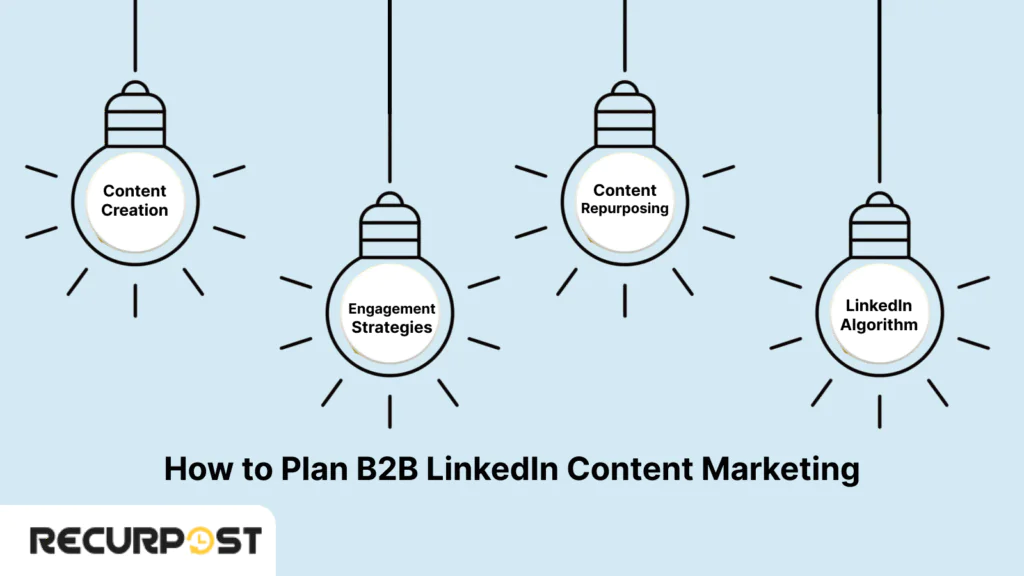
Creating and distributing content on LinkedIn requires a clear plan. Strong B2B LinkedIn content marketing plans balance educational vs. promotional content while keeping audiences engaged.
B2B LinkedIn content marketing works best when companies address target audience segmentation, share educational content, and maintain a steady content calendar. By applying smart engagement strategies, using hashtag optimization (3–5 per post), and adding clear CTAs, businesses can grow visibility while building meaningful connections. Repurposing existing work into native content formats like LinkedIn carousel posts or LinkedIn video content keeps campaigns fresh and cost-efficient.
Here are the steps for improving your B2B LinkedIn content marketing efforts:
Content Creation
- Publish content that speaks to business challenges faced by your target audience.
- Balance educational vs. promotional content: share case studies, how-to guides, and industry updates alongside company news or product updates.
- Plan with a content calendar maintenance system to support consistent posting (2–3x/week).
- Use content pillars to keep messaging aligned with business goals.
Engagement Strategies
- Apply hashtag strategy: 3–5 relevant hashtags per post to boost reach without hashtag stuffing.
- Insert call-to-action implementation that drives comment replies, shares, and click-through rates.
- Schedule posts at optimal posting times during work hours for higher engagement rates.
- Mix in visual content integration: images, infographics, or videos to hold attention.
Content Repurposing
- Transform blog content into LinkedIn articles, LinkedIn newsletters, or interactive elements like polls.
- Repurpose case studies into success stories for LinkedIn company pages.
Leverage the LinkedIn Algorithm
- The LinkedIn algorithm boosts posts with strong audience interaction. High engagement through question-based posts, comment-to-get technique, or pinned top comments) increases visibility. This drives stronger lead generation tactics, better conversion rates, and ultimately, more qualified leads from B2B LinkedIn marketing campaigns.
How to Increase LinkedIn Engagement for B2B
Strong engagement fuels successful B2B LinkedIn content marketing. Here are tactics B2B marketers can use to grow interaction, boost reach, and build stronger audience interaction:
1. Use Hook-First Copy: Lead your posts with a striking insight, surprising stat, or pain-point question. This hook-first copy approach grabs attention and increases engagement rates.
2. Ask Questions: Posts that end with a question often double the comment activity. Ask about industry trends, common challenges, or practical tips to spark conversations.
3. Tag Strategically: Mention clients, team members, or thought leaders. Smart strategic tagging increases visibility, encourages shares, and supports engagement response strategy.
4. Post When Your Audience Is Active: Best posting windows for B2B LinkedIn marketing are weekdays, especially Tuesday to Thursday, between 9–11 AM. These optimal posting times deliver stronger post frequency effectiveness and better click-through rates.
5. Comment-to-Get Technique: Instead of dropping links, use the comment-to-get technique: ask readers to type “yes” or “guide” to receive a resource. This quickly raises engagement metrics while signaling value to the LinkedIn algorithm.
6. Reply to Every Comment: Engage with your readers. Responding doubles interaction counts and improves visibility through content performance analytics signals.
7. Pin Top Comments: Highlight thoughtful replies to spark more discussion. Pinned responses act as social proof and inspire further audience interaction.
Use LinkedIn Features for B2B Marketing
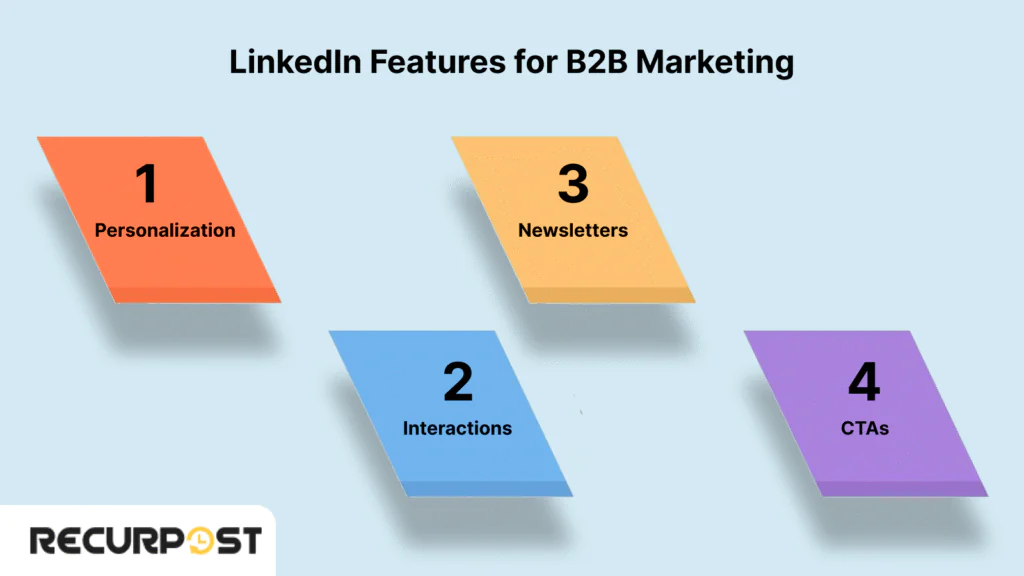
LinkedIn gives businesses multiple tools to expand visibility in B2B LinkedIn content marketing. Brands can share long-form insights through LinkedIn Articles, upload data-rich reports via document sharing, and stream real-time updates with LinkedIn Live.
Hosting LinkedIn Events brings communities together and positions your brand at the center of industry conversations. Adding LinkedIn case studies to these formats strengthens trust while showing real business outcomes.
Personal Branding vs. Company Page Content
While both matter, there is a growing demand for personalization in B2B LinkedIn marketing. Research shows that 73% of buyers prefer a B2C-style experience, even in B2B. Personal profiles allow first-person insights, helping leaders form authentic connections.
Balancing LinkedIn company pages with employee advocacy programs gives your brand a stronger, human touch. This mix boosts brand awareness indicators and creates an active professional network content marketing presence.
Engage with Your Audience
Stronger engagement strategies help build lasting relationships. Respond to comments, ask for feedback, and spark audience interaction around posts. LinkedIn groups participation connects you with like-minded professionals, encouraging community discussions and a stronger audience connection. Companies can also re-engage their existing networks by sharing educational content, success stories, or company culture posts to stay visible.
LinkedIn Newsletter Strategy
A LinkedIn newsletter keeps direct contact with followers and supports consistent outreach. Include educational vs. promotional balance in each edition, blending insights with updates. Measure success with engagement metrics like open rates, click-through rates, and conversions to refine your content calendar maintenance plan.
Call-to-Action Buttons
Every post should include a call-to-action implementation that directs users to webinars, downloads, or sales conversations. Clear CTAs not only raise conversion rates but also support lead generation tactics within your LinkedIn content marketing efforts.
How to Measure Success on LinkedIn
Tracking results is central to B2B LinkedIn content marketing. Measuring the right data helps confirm whether your campaigns reach the right audience and generate qualified leads.
Key Metrics to Track:
- Engagement rates: Watch likes, shares, and comments to see how your content connects with your target audience.
- Click-through rates (CTR): Track how many users click your links, showing if posts move traffic to your site or landing pages.
- Conversion rates: Measure actions such as form sign-ups or downloads, showing how well posts push leads through the sales pipeline.
- Impressions: Count how often posts are shown, reflecting the scale of your content’s reach.
- Reach: Track how many unique viewers see your content for accurate audience demographics insights.
LinkedIn Analytics Tools:
Built-in LinkedIn analytics tools reveal engagement patterns, content performance analytics, and audience targeting options. Regular reviews help refine posting frequency, support roi measurement, and guide analytics-driven adjustments to your content calendar.
Lead Generation:
Monitor lead generation tactics through LinkedIn lead gen forms or LinkedIn ads. Measure qualified leads from webinars, whitepaper downloads, or direct inquiries. These actions also help with sales attribution by linking campaigns to revenue.
Content Performance Over Time:
Study performance trends to see which content formats(videos, articles, polls, or case studies) drive consistent engagement strategies. This ongoing review helps with content repurposing and ensures future posts fit audience interaction needs.
Advanced Strategies for Boosting B2B LinkedIn Content Marketing
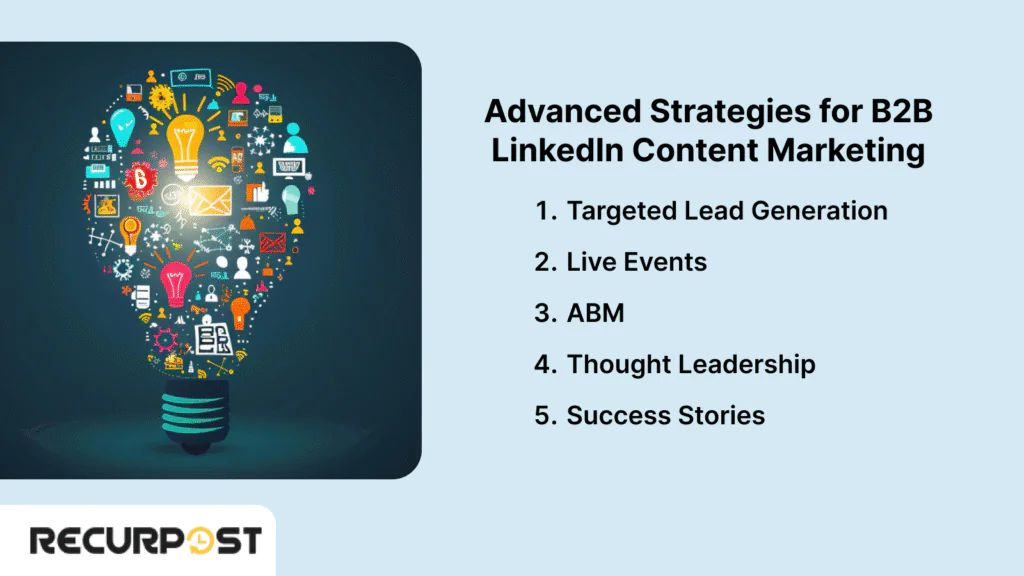
These advanced tactics expand the impact of B2B LinkedIn content marketing, ensuring higher visibility and lead generation across professional networks. Go beyond basic posting with advanced tactics that strengthen lead generation tactics, build trust, and increase brand awareness indicators. When applied consistently, B2B LinkedIn content marketing strategies give brands a measurable edge over competitors. These methods help B2B LinkedIn marketing campaigns stand out and deliver measurable results across the professional network.
Lead Generation with Targeted Content
Strong B2B content marketing on LinkedIn requires reaching decision-makers with audience-specific content. Use LinkedIn Ads, InMail messaging, and LinkedIn lead gen forms to connect with the right prospects. Personalized messaging that addresses real challenges drives better conversion rates and improves roi measurement.
LinkedIn Live for Real-Time Interaction
LinkedIn Live events and webinars create instant connections through Q&As and live demos. Real-time engagement builds trust and moves leads through the sales pipeline. By encouraging audience interaction during streams, businesses foster stronger ties and improve long-term engagement strategies.
Account-Based Marketing (ABM)
Account-based marketing (ABM) targets high-value accounts using LinkedIn’s audience targeting options. Tailored campaigns align with business-to-business LinkedIn strategy goals and help allocate resources toward qualified leads. This approach creates stronger sales attribution by linking campaigns to direct outcomes.
Thought Leadership Content
Publishing LinkedIn thought leadership marketing content keeps your business top-of-mind. Share LinkedIn thought leadership articles, industry insights posts, and first-person team insights. These efforts reinforce expertise, strengthen employee advocacy programs, and expand reach across professional network content marketing.
Showcase Case Studies and Success Stories
Share LinkedIn case studies, success stories, and company culture posts to build trust. These formats highlight content performance analytics in action by showing how your products and services deliver measurable results. Using these examples across LinkedIn company pages and personal profiles boosts credibility and encourages more audience connection.
LinkedIn B2B Best Practices
Here’s a sharp list of proven best practices for B2B LinkedIn content marketing. These steps help brands post with consistency, build recognition, and generate stronger audience interaction. The best practices for B2B marketing on LinkedIn include a mix of value-driven content, employee-led insights, and content types that favor the LinkedIn algorithm.
| Best Practice | Why It Works |
|---|---|
| Post consistently (2–3x/week) | Consistency in B2B LinkedIn content marketing builds brand familiarity and keeps you top-of-mind without overwhelming followers. Use a content calendar for consistent posting (2–3x/week). |
| Lead with value, not sales | LinkedIn audiences expect educational content, not constant pitches. Valuable posts strengthen engagement strategies and support long-term trust. |
| Leverage first-person insights from your team | Personal updates bring authenticity. First-person insights can deliver 2x more engagement rates compared to generic updates. |
| Use native content formats | LinkedIn favors native content formats such as carousels, LinkedIn documents, and text posts. This boosts post frequency effectiveness. |
| Mix up content types | Alternate between LinkedIn articles, videos, polls, and carousels to appeal to different audience-specific content preferences. |
| Include clear CTAs in every post | Strong call-to-action implementation encourages comments, shares, and downloads. CTAs drive conversion rates and measurable roi measurement. |
| Encourage employee advocacy | Employee advocacy programs give posts 561% more reach than LinkedIn company pages alone, multiplying visibility for B2B LinkedIn content marketing campaigns. |
Common Mistakes to Avoid in B2B LinkedIn Content Marketing
To strengthen your B2B LinkedIn content marketing, avoid these errors that weaken engagement strategies, slow lead generation tactics, and reduce overall impact:
Over-Promotion vs. Value-Driven Content
Heavy promotion can push away your target audience segmentation. Balance content with a 70/30 educational vs. promotional balance. Share industry insights posts, success stories, and how-to guides to create value. This mix builds trust, fuels relationship building, and positions your business as a credible voice.
Hashtag Stuffing
Excessive hashtags make content look cluttered. Instead, follow a smart hashtag strategy: use 3–5 relevant hashtags tied to your content pillars and industry. This approach raises audience interaction without flooding posts with irrelevant tags.
Hashtags That Bring Business
Instantly generate high-impact LinkedIn hashtags to reach the right B2B audience.
“This tool boosted our LinkedIn impressions by 4x. A must for B2B growth!” – B2B Marketing Strategist
Start Reaching the Right Audience – Free Access
Inconsistent Posting
Irregular posting weakens LinkedIn marketing efforts. A steady schedule of consistent posting (2–3x/week) supported by content calendar maintenance keeps campaigns on track. Mixing long-form content, video content, and carousels helps maintain variety and drive audience interaction.
Ignoring Engagement Metrics
Skipping engagement metrics makes it harder to see what’s working. Track engagement rates, audience demographics, and content performance analytics with LinkedIn analytics tools. These insights refine engagement strategies and guide better lead generation tactics.
Text-Heavy Posts Without Visuals
Posts that rely only on text often underperform. Add visual content integration such as images, infographics, or LinkedIn video content. Visuals improve brand recognition and attract more potential clients, helping posts gain traction.
Neglecting the Content Calendar
Without a content calendar, posts may appear scattered. Content calendar maintenance supports consistency, aligns with industry trends, and helps structure campaigns for better reach within your professional network content marketing.
Conclusion
B2B LinkedIn content marketing is more than posting updates. It’s about building real connections and driving growth inside LinkedIn’s professional network. Businesses that refine their B2B LinkedIn content marketing see stronger engagement, better-qualified leads, and long-term growth. By sharing thought leadership content, applying smart lead generation tactics, and maintaining consistent posting, you can strengthen brand awareness indicators and reach your target audience.
LinkedIn continues to offer unmatched opportunities for engagement strategies, visibility, and relationship building. Use this platform to spark audience interaction, expand reach, and turn campaigns into lasting success. Now is the time to refine your LinkedIn content marketing strategy and scale your impact with B2B LinkedIn content marketing.
FAQs on B2B LinkedIn Content Marketing
1. How do I create an effective B2B LinkedIn content strategy?
Start by tailoring posts to your target audience segmentation. Mix thought leadership content, industry insights posts, and success stories. Maintain steady activity with content calendar maintenance and join LinkedIn groups to grow relationship-building.
2. What types of content perform best for B2B LinkedIn content marketing?
Formats such as video content, long-form content, and how-to guides work well for B2B LinkedIn content marketing. These posts highlight your company’s values, attract audience interaction, and build credibility.
3. How does LinkedIn’s algorithm affect my content’s visibility?
The LinkedIn algorithm favors posts with high engagement rates. Share relevant formats, apply a hashtag strategy with 3–5 tags, and invite comments or shares. Higher engagement boosts your content’s reach across your professional network.
4. How can I measure the success of my LinkedIn content marketing efforts?
Track engagement metrics such as likes, shares, and click-through rates. Use LinkedIn analytics tools to measure lead generation tactics, audience demographics, and content performance analytics. These insights refine your B2B LinkedIn content marketing plan over time and ensure your overall B2B LinkedIn content marketing efforts deliver measurable results.
5. Should I focus only on LinkedIn for B2B marketing?
LinkedIn is the strongest hub for B2B LinkedIn marketing, but expanding into other social media channels like Twitter or Facebook increases exposure. A multi-channel content strategy builds reach, generates qualified leads, and strengthens overall visibility.

Ruchi Dhimar is a skilled content writer with 5 years of experience. She is passionate about crafting compelling narratives, specializing in writing content for different industries.

